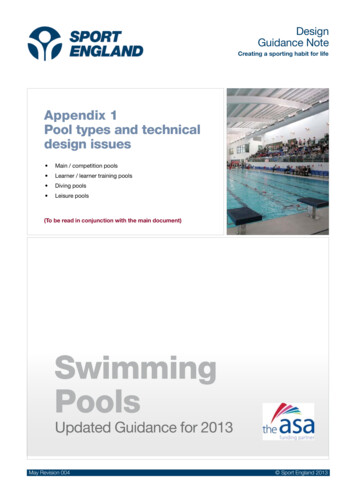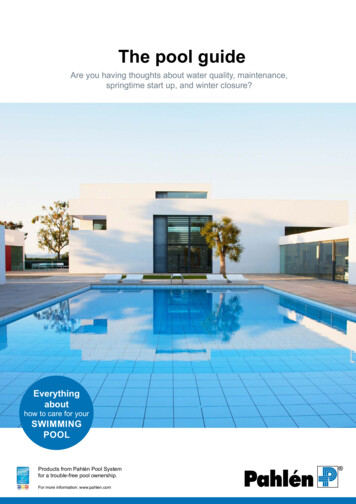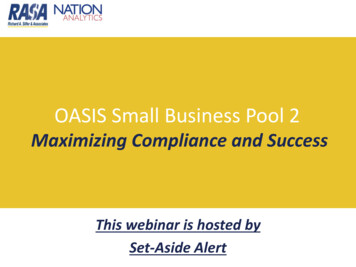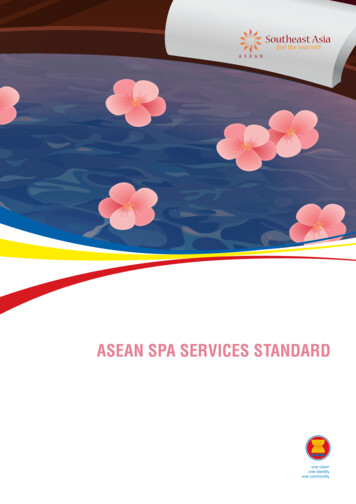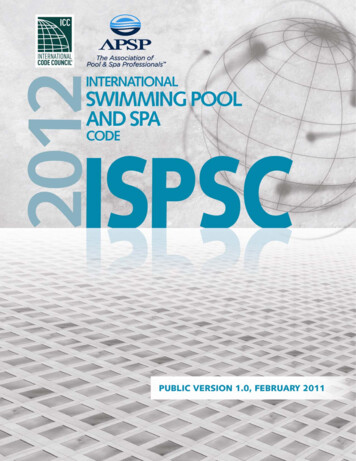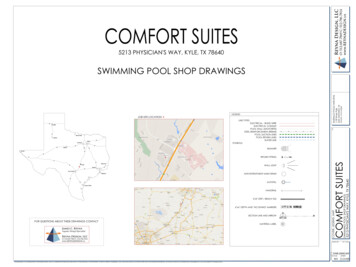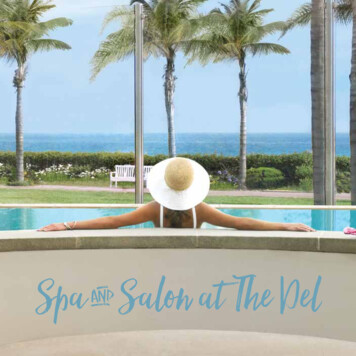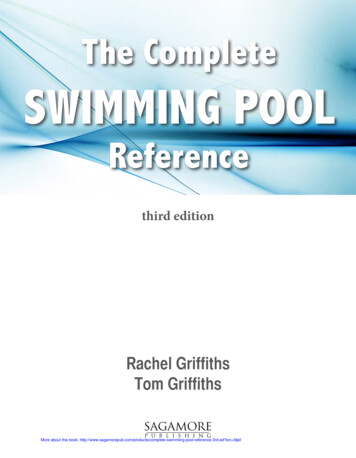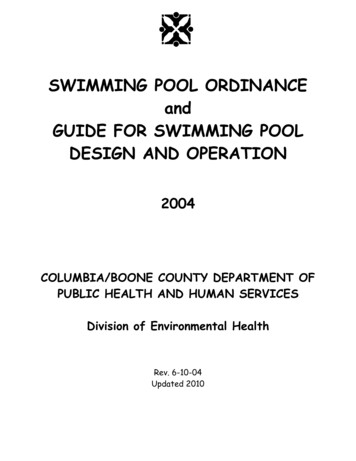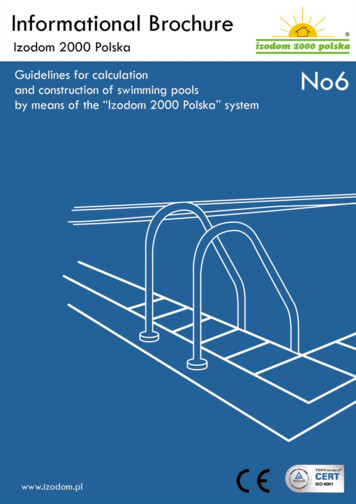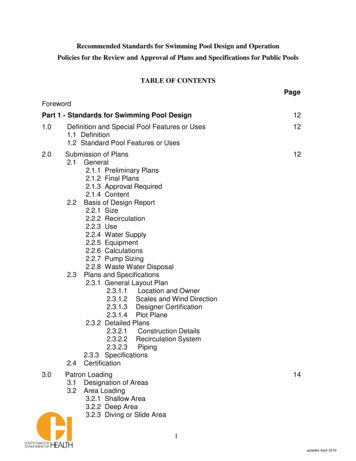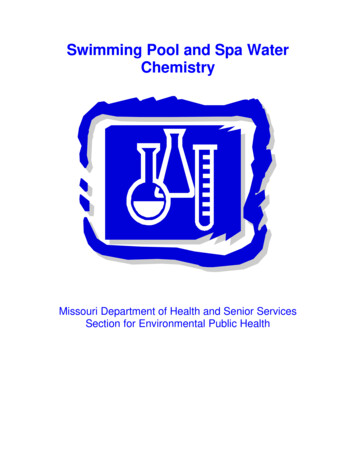
Transcription
Swimming Pool and Spa WaterChemistryMissouri Department of Health and Senior ServicesSection for Environmental Public Health
Table of ContentsWater Sanitizing rinationCombined chlorineBreakpoint chlorinationInorganic and Organic ChlorineEffect of pH on ChlorineChlorine GasSodium HypochloriteCalcium HypochloriteLithium HypochloriteLithium HypochloriteChlorinated IsocyanuratesChlorination SummaryAlternative SanitizersBromineIodineOzoneElectrolytic CellsBrine MethodIn-Line MethodAutomationSilverNon-Chlorine -OxidizersOther Pool ChemicalsFlocculantsAlgaecidesChelating or Sequestering AgentsDegreasersDefoamersCyanuric AcidBalanced WaterChlorideBromidepHTotal AlkalinityTotal HardnessTotal Dissolved SolidsStabilizer
Pool and Spa Water Testing and Testing RoutinesChlorineBrominepHTotal AlkalinityTotal HardnessTotal Dissolved SolidsSuperchlorination or ShockingAdding Chemicals to WaterGlossary of Terms – Water chemistryTroubleshooting GuidePoolSpaAdvanced Pool and Spa Water ChemistryChloraminesOTODPD
GeneralOn a hot summer day, who wouldn't want to jump into a cool and refreshing pool? Andthen, as the sun sets, what better way to relax than to slip into your own backyard spa -summer or winter?But enjoying all that requires some regular attention. Remember, the water in your pooland spa is an ever-changing environment that calls for constant and careful monitoring.For some, this means hiring a professional service technician to come by once or twicea week. You can, however, take care of your pool and spa yourself.The need to treat water has been widely accepted for a long time. Sanitation, especially,is recognized as a means of controlling communicable diseases. The pool operator isexpected to provide safe, clean water for bathers.More recently, however, the importance of mineral saturation, or 'water balance" as it ismore popularly known, is recognized by those responsible for maintaining the pool andequipment. Water can become aggressive and destroy pools with corrosion, or it canbecome scaling and damage the pool with mineral deposits.The pool operator must learn about the use of chemical agents for sanitation and forcontrol of pH, total alkalinity and calcium hardness. The operator is expected to protectboth the swimmers and the pool itself. This chapter is written to present the necessarychemical treatments and sufficient background information to know when and how touse them.Here's a basic guide to pool and spa water chemistry. It will give you a general outline ofthe issues that shape routine care.Water Sanitizing ComponentsAs you probably know, the occasional addition of new water -- or wholesale waterreplacement in the case of spas -- isn't enough to keep the water clean and clear ofunwanted and often microscopic contaminants.But worry not! Pool and spa chemists have spent years developing a variety of testsand chemical-treatment methods to keep your pool and spa safe and sparkling clean.
Your goals here are water sanitation and water balance. In other words, you want yourlevels of sanitizers (such as chlorine or bromine) and your levels of pH, total alkalinity,water hardness and total dissolved solids to all fall within acceptable limits.And learning to keep these areas in check isn't as complicated as it may seem. Tosimplify things, we'll explain the relevant topics one at a time.SanitizersSanitizers, or disinfectants, are hardworking chemicals. They also have a killingstreak in them -- which is exactly what you want.The important thing to keep in mind is, that for them to do their duty, they have to bepresent in the pool and spa water at all times. There always needs to be a certainminimum amount -- called a residual -- of sanitizer in your water.What we're saying is, to make sure your pool and spa are protected from bacteriaand their friends, you need your sanitizers on 'round-the-clock duty.When you add your sanitizer, therefore, you should be adding enough to kill anyexisting contaminants in the water -- and create a residual that can neutralize anydirt, debris or germs that may get into the water before you next treat it.That said; let's take a look at some of the most common sanitizing chemicals andequipment available on the market today.BromineAlso available on the market today is a chemical sanitizer called bromine. Do note,however, that bromine cannot be stabilized with cyanuric acid. As much as 65percent of bromine residual can be depleted by the sun in a two-hour time period.Because there is no known way to retain a reliable level of bromine when exposed tosunlight, many experts recommend it for indoor pools or spas only.FYI: The acceptable range of bromine for your pool or spa is from 2.0 to 4.0 ppm.Bromine also has no odor, and dispensing it your spa via a feeder allows it todissolve at a slow, constant, desirable rate. Just be sure to remove the feeder whenyour spa is in use.A final note: When using bromine as your sanitizer, you will need to occasionallyshock the water with large doses of another chemical to oxidize waste material still inthe water. (We'll explain this in more detail below.)ChlorineChlorine has been somewhat of a wonder drug for pool and spa environments. It hasthe power to kill bacteria and algae -- and works extremely well in aqueousenvironments.Chlorine is not invincible, however. Like most chemicals, it has a threshold -- a pointat which it has used up all its sanitizing power and can no longer protect your pooland spa water.Chlorine levels are also heavily influenced by evaporation, splash out and destructiveUV rays, not to mention a low pH. (You'll read about this last factor in more detailbelow.)
Once added to the water, the "free available" chlorine -- that portion of the chlorinewith the killing power -- will sanitize and oxidize the water by attacking undesirablessuch as bacteria, algae, sweat and oils from your skin, residual soaps, shampoos,perfume and, yes, urine.As it uses up its killing potential, the chlorine becomes ineffective or it combines withthe contaminants and remains in the pool and spa water in the form of chloramines.FYI: It is the chloramines in your pool and spa water -- not too much "good" chlorine - that causes a chlorine-like odor and can irritate your eyes and skin.Indeed, when a pool or spa exudes a chlorine odor and you begin to hear complaintsof skin and eye irritation, that is a loud warning that there is not enough chlorine inthe water. If this is the case, you should test the water and add the appropriateamounts of sanitizer as soon as possible. (Check out the Testing Your Water sectionto learn more about this process.)The recommended level of free available chlorine to keep in your pool is between 1.0and 3.0 ppm or parts per million. For spas, the recommended level of free availablechlorine is between 1.50 and 3.0 ppm.(For the definition of parts per million and other pool- and spa-related terms, see theGlossary of Terms section).Another note: We'll address how you measure chlorine and other water-balancelevels in another section.Chlorine is extremely susceptible to sunlight and needs to be regularly monitored.But just as we use sunscreen to protect our skin from the sun, chlorine uses asunscreen of cyanuric acid. Used this way, cyanuric acid is also commonly called astabilizer or conditioner.With its help, chlorine retains its effectiveness. Without going into the chemical whysand wherefores, know that acid works to help keep a fairly consistent chlorine level(a residual) in the water.Some chlorine-based sanitizers are sold with a dose of cyanuric acid already mixedinto the product. One such product is trichlor tablets, (trichloro-s-triazinetri ) arewhich are usually placed in a floater, chemical feeder or in the skimmer basket.Another commonly used product is sodium dichlor,(dichloro-striazinetrione) which isa granular substance usually dispersed directly into the pool or spa water, or addedvia the skimmer.
OxidizersOK, you've been reading about oxidizers and oxidizing -- and still have no idea whatthey are or what they do. Let's find out.Oxidizers work with sanitizers to rid your pool and spa water of pollutants. Bydefinition, sanitizers kill things like algae and bacteria but they work very slowly andinefficiently when trying to remove waste products such as sweat, skin oil,shampoos, soap and urine. This is where you need separate oxidizers.Oxidizers destroy these undesirables. They do their part by breaking down thecontaminant's structure, rendering them vulnerable. The sanitizers can then attackand kill the organisms.Some products, such as chlorine, act as both a sanitizer and an oxidizer. Bromine,on the other hand, does not oxidize very well and therefore needs the aid of aseparate oxidizing chemical to properly clean your pool and spa water.The marriage of sanitizers and oxidizers is an almost foolproof method of keepinginvaders out of your pool and spa water.Sanitizers AlternativeAlthough chlorine and bromine are the most commonly used sanitizers, there are afew alternatives available to also consider. One such alternative is a chlorinegenerator.Wait, we just discussed chlorine! How is this product different?The liquid or granular chlorine most people are familiar with is added directly to poolor spa water or dispensed through a feeder or similar automated system. Chlorinegenerators, conversely, actually create chlorine in the pool or spa without you havingto measure out any chemicals.These generators are electrical devices that manufacture chlorine from salt added tothe water. The resulting chlorine gas is then put directly into the water through thecirculation system.Chlorine generators create a residual, which can be tested with a DPD or OTO testkit. (These test kits are described in more detail in a later section.)Another alternative sanitizing source is ozone. No, it's not just the atmospheric layerthat protects us from the sun's harmful rays. Rather, the ozone used in pools andspas is a modified version of that gaseous oxygen.To its advantage, ozone works quite well as a sanitizer and an oxidizer. . Because itis a form of oxygen, ozone doesn't last long in an aqueous environment. Once it doesits job of ridding the pool and spa water of bacteria and other unwanted matter, theozone then reverts back to oxygen and either dissolves into the water or escapesinto the air.Because it cannot create a residual, an ozonator must be used in conjunction withsmall amounts of chlorine or bromine -- how much chlorine or bromine depends onhow long the ozonator is run each day .One other common kind of sanitizingequipment is an ionizer. This system introduces silver and copper into your pool orspa water through the circulation process. It works well as a sanitizer but doesrequire the addition of an oxidizer.
ChlorinationThis is the most commonly used method of sanitation today. Bromine and iodine areother members of the halogen family of chemicals also used to sanitize water. Otherchemicals include ozone, silver and copper compounds. Ultraviolet light is anonchemical disinfectant. Each of these methods will be covered to some extent, butchlorination is presently the most widely accepted means of treating pool water.All chlorine - regardless of whether it is introduced as a gas or as a dry or liquidcompound when added to water, does exactly the same thing: It forms hypochlorousacid (HOCI) and hypochlorite ions (OCI-).HOCl is the killing form of chlorine; OCI- is relatively inactive. However, together, theyare free available chlorine (FAC).Because each of the many chlorinating agents produces the same active form ofchlorine, we can ignore the source for now and deal with the process of chlorination ingeneral.HOCI is an extremely active, powerful chemical. It not only destroys such harmfulorganisms as bacteria, algae, fungi, viruses, etc., it also destroys impurities that are notremoved by filtration. These two processes are called sanitation and oxidation.SanitationSanitation is the process of destroying organisms that are harmful to People. Theseorganisms, referred to as pathogens, include bacteria, fungi, viruses, etc. Chlorinationalso controls algae (which are not usually harmful themselves, but may harborpathogenic organisms). In addition to being unsightly, algae can cause the surfacesaround the pool to become slippery and unsafe.While each of these organisms may require different amounts of HOCI for control, localhealth officials often establish the required amount for public swimming pools. Veryoften, local codes will specify an FAC residual of 1.0 -3.0 parts per million (ppm), butsome might vary from this.OxidationOxidation is the process of chemically removing organic debris, such as body waste,particulate matter and perspiration, from the water. The process is similar to burningtrash in air. It is not important to understand the chemistry involved; it is sufficient toknow that enough chlorine in water will chemically "burn" impurities.The use of chlorine to clean up water is a supplement to filtration, discussed in anotherchapter. Filters remove the dirt and debris suspended in water, but even the best filtercannot remove dissolved impurities because they are not physically separate from the
water. If the water looks dull or hazy, even though the filter system is operating properly,the operator should consider a shock treatment to oxidize the organic impurities andrestore the clarity of the water. Although there are some non-chlorine shock treatmentsavailable, the most common method used to shock water is on is a term that describes an extra large dose (usually 8 to 10 ppm) ofchlorine to oxidize organic compounds and kill and remove algae and othercontaminants from the water. This is the same as using three to six times the normaldosage of a chlorinating agent. For example, a 50,000-gallon pool requires about fourgallons of liquid pool chlorine (12% Available Chlorine) or six pounds of a granularchlorinating compound such as calcium hypochlorite (65% Available Chlorine).As mentioned, HOCI is the form of chlorine that provides sanitation. Because it is anextremely active chemical, however, it also reacts with organic impurities. When there isenough HOCI present, the impurities are completely oxidized. Combined chlorine isformed when there is an insufficient supply of HOCI or when there is a very high level oforganic impurities. Combined chlorine compounds can be oxidized by increasing theHOCI level in the water. The point at which all the organic impurities are oxidized iscalled the breakpoint. The addition of sufficient chlorine to reach this point is known asbreakpoint chlorination.Combined ChlorineCombined chlorine is formed by chlorine combining with ammonia and other nitrogencontaining organic compounds. Some sources of these compounds includeperspiration, urine, saliva and body oils. These combined forms of chlorine, also calledchloramines, are still disinfectants, but they are 40 to 60 times less effective than freeavailable chlorine.Chloramines kill slowly, so when they are formed in swimming-pool water, the FAC is nolonger present for "instant kill" sanitation. Free available chlorine and combined chlorineexist together in many pools. There are simple tests to measure the levels of each.These will be described in detail in another chapter.In addition to reduced effectiveness against bacteria, chloramines cause eye irritationand the so-called 'chlorine odor" that swimmers complain about. Chloramines have afoul, irritating odor; free chlorine in water in normal concentration has no discernableodor.Breakpoint ChlorinationWhen chloramines are known to be present, either by test (over 0.2 ppm combinedchlorine) or because of a foul chlorine odor, the continued addition of chlorine causes acorresponding rise in measurable chlorine residual, but eventually, a point is reached at
which addition of chlorine causes a sudden drop in residual. This phenomenon isaccompanied by a reduction in eye irritation and chlorine odor.Investigation reveals that when the total concentration of chlorine in the water reachesseven times the amount of combined chlorine, the oxidation of chloramines and otherorganic compounds is complete. The point of residual concentration at which thissudden reaction occurs is called the breakpoint. Chlorine remaining or added after thebreakpoint is reached exists as free residual chlorine, and all the combined residual isoxidized. The breakpoint varies in its speed and amplitude, depending upon the organicmatter present. In some waters, the breakpoint is hardly discernible.The practice of periodic superchlorination is actually an attempt to pass the breakpointto rid the water of an accumulation of combined chlorine and potential chlorineconsuming compounds.Figure 1 - Graph of breakpoint phenomenonInorganic and Organic ChlorineInorganic chlorine compounds such as calcium hypochlorite, sodium hypochlorite and lithiumhypochlorite, as well as chlorine gas, are greatly affected by direct sunlight. They require theaddition of cyanuric acid to be stabilized when used in outdoor pools. These products arerecommended for indoor swimming pools.Organic chlorine compounds are products combined with cyanuric acid. Sodium dichlorostriazinetrione ("dichlor') and trichloro-s-triazinetri-one ('trichlor) are both popular stabilizedchlorines for water treatment of outdoor pools.Calcium hypochlorite will support combustion and must never be mixed with carbonated drinks,oils of any type or an organic chlorine product such as "dichlor' or 'trichlor' - explosions canresult.
Figure 2 - Disinfection time for free and combined chlorine residuals at various pH values.Effect of pH on ChlorineThe pH of water has a definite effect on the efficiency of chlorine as well as on thecorrosive properties of water (covered later in this chapter.) For now, we will consideronly the effect of pH on sanitation.It can be seen in Table 2.a that free chlorine is most efficient in pH ranges below theideal range of 7.2-7.6. Some pool operators do, however, maintain pH levels higherthan the ideal range. They should also maintain appropriately higher FAC levels toprovide the same concentration of the active HOCL form.For example, at a pH of 8.0, 21% (about 1/5 of the FAC is in the active form. At that pHlevel, it would take 2.5 ppm of FAC to provide about 0.5 ppm of HOCI. At a pH of 7.5,about 1/2 (50%) of the FAC is in the active HOCI form. At that pH level, it would takeonly 1.0 ppm of FAC to provide the same 0.5 ppm of HOCI. For this reason, manyauthorities recommend that the pH of pools be maintained in the range between 7.2 and7.6 and as close to 7.5 as practical. These conditions are also considered to be mostcomfortable for the swimmers' eyes and skin.HOCIH*OCI-Hypochlorous AcidHypochlorite IonKilling AgentHydrogen IonInactive, but stable formActive, but unstable form% Chlorine as HOCIpH% Chlorine as OCI-906.510
737.027667.234457.655218.079108.590Chlorine Gas (Cl2)Chlorine gas has 100% available strength, is very toxic and can be lethal if an operatoris overcome by it. This form of chlorine is the most economical, pound for pound, butthe laws regarding safety practices and the intricate feeding equipment it requires makeit a feared method of water sanitation. Chlorine gas for pool use is contained underpressure in steel tanks as large as one ton. The gas is green in color and heavier thanair.Strict adherence to the following practices is required for minimum safety:1. Chlorine tanks should always be sto red indoors in a fire-resistant building.2. Tanks and chlorinator must be kept in a separate room with a vent fan capable ofcomplete air exchange in one to four minutes.3. Tanks must be chained or strapped to a rigid support to prevent accidentaltipping.4. A self-contained air supply gas mask must be immediately available in case ofemergencies.5. The chlorinator and all tanks should be checked daily for leaks. A small amountof ammonium hydroxide (household ammonia) on a piece of cloth produceswhite vapor i n the presence of chlorine.Sodium Hypochlorite (NAOCl)Sodium hypochlorite is a clear, slightly yellow liquid solution used in dilute form ascommon household bleach. In its commercial form, it provides 12% to 15% availablechlorine. The chemical is usua lly introduced to pool water through a chemical feeder,but it can be poured directly into the pool for a quick increase in chlorine residual. It hasno sediment or precipitate and raises Total Dissolved Solids (TDS). This chemical has apH of 13 and causes a significant increase in the pool's pH. The occasional addition ofmuriatic acid or sodium bisulfate can correct the increased pH, however.Sodium hypochlorite is not stable in storage and gradually loses strength, especially insunlight. If stored in a dark, cool room, it has a one-month shelf life.Dilute solutions of sodium hypochlorite can be used for poolside sanitation and fordisinfecting and cleaning decks. The chemical should not be spilled directly on clothes
and should be immediately washed off if it gets on the skin. However, its safety and lowcost has made this a very popular chlorinating agent.Calcium Hypochlorite (Ca(OCl)2)Calcium hypochlorite is available in granular or tablet form. It provides 65% availablechlorine by weight and remains stable if stored in a dry, cool area. The chemical can bedissolved and introduced to the pool as a liquid, or it can be added in dry form. Whenapplied directly to the pool, it may cause a temporary cloudiness. Direct applicationsshould be broadcast e venly over the water surface to avoid bleaching the pool bottomas a result of having a concentrated amount in one spot. This must be done when nobathers are in the pool.This chemical, when contaminated by or mixed with an organic compound, can producea fire. A good rule is never to mix calcium hypochlorite with another chemical or store itin anything but the original container. Mix the chemical into water not water into thechemical. Calcium hypochlorite should not be handled with bare hands and must bekept off the operator's clothes.As a chlorinating agent, calcium hypochlorite will slightly increase pool pH. It has a pHof 11.8. Operators of gas-chlorinated pools often keep a supply on hand for emergencyuse or for a quick charge when superchlorinating. Dissolved in water, calciumhypochlorite can be used as a sanitizing agent for decks and locker rooms.GASCHLORINESODIUM HYPO CALCIUM HYPO LITHIUM BLECHLORINE100%12.15%65-75%35%56% OR62%90%pH EFFECTLOWERS(pH 1.0)RAISES(pH 13.0)RAISES(pH 11.8)RAISES(pH 10.7)NEUTRAL(pH 6.9)LOWERS(pH 2.9LOST UIDGRANULAR &TABLETSPOWDERGRANULARGRANULAR&TABLETSLithium Hypochlorite (LIOCl)Lithium hypochlorite is a newer entry in the field of chlorinating agents. Its cost isgreater than other hypochlorites, and it provides only about 35% available chlorine.However, the chemical is fast dissolving and totally soluble in water, and pH tends torise more slowly with its use than with other chemicals. It has a pH of 10.7. Lithiumhypochlorite should not be mixed with organic compounds, but it is safer to store anduse than calcium hypochlorite.
Chlorinated lsocyanurates(Stabilized Chlorine)This family of chemicals is in wide use for swimming pool chlorination. The family iscomposed of sodium dichloro-s-triazinetrione and trichloro-s-tria zinetrione - chlorinecompounds that contain cyanuric acid (stabilizer). The dichlor is more soluble andprovides 56% or 62% available chlorine, depending on formulation. dichlor provides90% available chlorine and is used when a slow release of chlorine over a period oftime is desired. The dichlor compound has little effect on pH, while trichlor is extremelyacid (pH 2.8 -3.0). Dichlor can be added directly to the pool; trichlor is generally fedthrough an erosion-type feeder, but never through the skimmer basket.The major effect of cyanuric acid on hypochlorous acid (HOCI) is to keep it from beingdecomposed by ultraviolet (LTV) light such as contained in sunlight.Because it is readily decomposed by LTV light, the dosage of a chlorinating agent thatis sufficient for an indoor pool is dissipated rapidly in an outdoor pool. Cyanuric acidbonds with the available chlorine in a manner that does not use up the chlorine. At highstabilizer levels (over 100 ppm), chlorine's efficiency may be reduced. The operatorshould consult the local codes and manufacturers' recommendations on the proper useof stabilizers.Chlorination SummaryoooooChlorination both sanitizes and cleans the water by oxidizing organic impurities.A free chlorine residual of 1.0 -3.0 ppm is preferred. Combined chlorine shouldnot exceed 0.5 ppm and may be destroyed by breakpoint chlorination.Proper pH control (7.2-7.6) provides better chlorine efficiency.When cyanuric acid is used in an outdoor pool, chlorine consumption is reduced,because the chlorine degradation caused by LTV light is reduced.There are many chlorinating agents available but each provides HOCI, the activechemical specifically for disinfecting.ALTERNATIVE SANITIZERSOther members of the halogen family - bromine and iodine - are used for treating poolwater. New developments in the use of ozone, ultraviolet light, ionization of salts andother chemical compounds continue to provide new challenges and techniques in watertreatment.BromineAlthough bromine in its elemental form is a liquid, it is not available for swimming pooldisinfection in that form. Elementa l bromine is a heavy, dark brown, volatile liquid withfumes that are toxic and irritating to eyes and respiratory tract. For pool sanitation,bromine compounds are sold in two solid forms - a two-part system that uses a bromide
salt dissolved in water and activated by addition of a separate oxidizer; and a one-partstick or tablet that contains both bromine and an oxidizer and is dispensed by anerosion-type feeder.The chemistry of bromine is similar in many respects to the chemistry of chlorine;however, bromine cannot be used for shock treating.Bromine has a pH of 4.0-4.5. When bromine is added to water and an oxidizer ispresent, the bromine forms hypobromous acid (HOBR) and bypobromite ions (OBr).Like chlorine, the percentage of each is affected by pH. However, the effect is not asdramatic as it is with chlorine. Table 2.c displays the effect of pH on bromine. Likechlorine, bromine combines with organic impurities to form combined bromine orbromamines. However, combined bromine is still an effective sanitizer, and it does notsmell. Because of this, bromine is popular for spas.HOBrHypobromous Acid% Bromine as HOBrpHOBrHypobromite Ion% Bromine as .017.057.08.543.0IodinePotassium iodide (KI) is a white, crystalline chemical that dissolves in water without aprecipitate. When activated by the presence of an oxidizer, it is converted tohypoiodious acid (HOI). Iodine does not react with ammonia to produce iodamines; itdoes not bleach hair or swimming suits, and eye irritation is practically nonexistent.Other chemicals (usually chlorine) must be used in conjunction with iodine to controlalgae and oxidize organic matter. The sole effect of iodine is to produce bacteria-freewater.OzoneOzone was first used as a water sanitizer in France in the early 1900s. It is the mostpopular method of treating drinking and pool water throughout Europe. Ozone is one ofthe strongest oxidizers available for treating swimming and spa water and is growing inpopularity in the U.S.A. It kills bacteria and oxidizes organic compounds includingchloramines, soaps, oils and bather wastes and does not alter the water's pH. Due to
limitations of the amount of ozone that can be economically introduced to pool and spawater, algae growth is not eliminated and may possibly increase.Two systems have been developed for the production of ozone for pool and spa water.The most common European method - and the most expensive - is the CoronaDischarge. This method generates ozone by exposing pressurized, dried air to highvoltage electricity. The ozone gas is then directed into the bottom of the pool and seenas very small bubbles rising to the surface. The ozone can be introduced into aseparate chamber or directly to the pool.The Ultraviolet (LTV) or photochemical method of ozone production passes thepressurized, dried air next to a UV bulb within a chamber, where the UV rays bombardthe oxygen molecules and produce ozone. A single LTV lamp is capable of treatingapproximately 10,000 gallons of water. The UV method is more common for spas orprivate small pools and is less expensive to operate. The LTV method cannot match theoutput of the Corona Discharge method.Once it has done its job as an oxidize r, ozone reverts to oxygen and improves bothsmell and taste of the water. This factor is worth noting, especially for indoor pools.Ozone has to be continually generated, because its effectiveness is about 22 minuteswhile the gas remains in the water. Ozone offers no continuous residual, and because itis not effective against algae growth, most manufacturers recommend that ozone beintroduced with a halogen such as chlorine or bromine.Testing of ozone residual is in parts per billion (ppb). Test kits are available that useDPD as the reagent and color calibrations that indicate readings from 0 to 100 ppb.Testing with the use of an Oxidation Reduction Potential (ORP) meter is effective, and aminimum level of 650 millivolts is recommended. Because ozone of the smallestresidual is effective and adequate for treating water, when combined with chlorine orbromine, a test reading of either is an indication of the effectiveness of the ozone.ELECTROLYTIC CELLSElectrical devices (chlorine generators) have been devel
Swimming Pool and Spa Water Chemistry Missouri Department of Health and Senior Services Section for Environmental Public Health . Table of Contents Water Sanitizing Components Chlorination Sanitation Oxidation Sup
